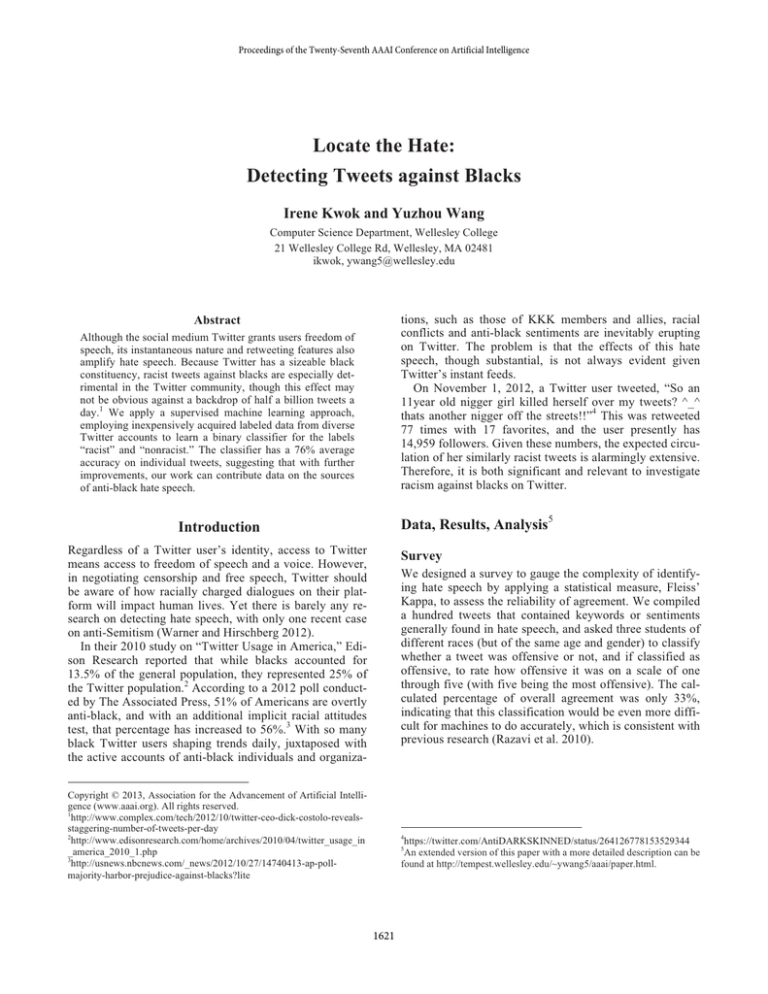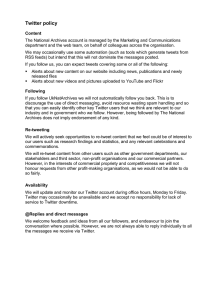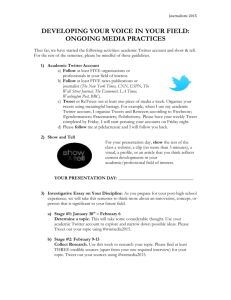
Proceedings of the Twenty-Seventh AAAI Conference on Artificial Intelligence
Locate the Hate:
Detecting Tweets against Blacks
Irene Kwok and Yuzhou Wang
Computer Science Department, Wellesley College
21 Wellesley College Rd, Wellesley, MA 02481
ikwok, ywang5@wellesley.edu
tions, such as those of KKK members and allies, racial
conflicts and anti-black sentiments are inevitably erupting
on Twitter. The problem is that the effects of this hate
speech, though substantial, is not always evident given
Twitter’s instant feeds.
On November 1, 2012, a Twitter user tweeted, “So an
11year old nigger girl killed herself over my tweets? ^_^
thats another nigger off the streets!!”4 This was retweeted
77 times with 17 favorites, and the user presently has
14,959 followers. Given these numbers, the expected circulation of her similarly racist tweets is alarmingly extensive.
Therefore, it is both significant and relevant to investigate
racism against blacks on Twitter.
Abstract
Although the social medium Twitter grants users freedom of
speech, its instantaneous nature and retweeting features also
amplify hate speech. Because Twitter has a sizeable black
constituency, racist tweets against blacks are especially detrimental in the Twitter community, though this effect may
not be obvious against a backdrop of half a billion tweets a
day.1 We apply a supervised machine learning approach,
employing inexpensively acquired labeled data from diverse
Twitter accounts to learn a binary classifier for the labels
“racist” and “nonracist.” The classifier has a 76% average
accuracy on individual tweets, suggesting that with further
improvements, our work can contribute data on the sources
of anti-black hate speech.
Data, Results, Analysis5
Introduction
Regardless of a Twitter user’s identity, access to Twitter
means access to freedom of speech and a voice. However,
in negotiating censorship and free speech, Twitter should
be aware of how racially charged dialogues on their platform will impact human lives. Yet there is barely any research on detecting hate speech, with only one recent case
on anti-Semitism (Warner and Hirschberg 2012).
In their 2010 study on “Twitter Usage in America,” Edison Research reported that while blacks accounted for
13.5% of the general population, they represented 25% of
the Twitter population.2 According to a 2012 poll conducted by The Associated Press, 51% of Americans are overtly
anti-black, and with an additional implicit racial attitudes
test, that percentage has increased to 56%.3 With so many
black Twitter users shaping trends daily, juxtaposed with
the active accounts of anti-black individuals and organiza-
Survey
We designed a survey to gauge the complexity of identifying hate speech by applying a statistical measure, Fleiss’
Kappa, to assess the reliability of agreement. We compiled
a hundred tweets that contained keywords or sentiments
generally found in hate speech, and asked three students of
different races (but of the same age and gender) to classify
whether a tweet was offensive or not, and if classified as
offensive, to rate how offensive it was on a scale of one
through five (with five being the most offensive). The calculated percentage of overall agreement was only 33%,
indicating that this classification would be even more difficult for machines to do accurately, which is consistent with
previous research (Razavi et al. 2010).
Copyright © 2013, Association for the Advancement of Artificial Intelligence (www.aaai.org). All rights reserved.
1
http://www.complex.com/tech/2012/10/twitter-ceo-dick-costolo-revealsstaggering-number-of-tweets-per-day
2
http://www.edisonresearch.com/home/archives/2010/04/twitter_usage_in
_america_2010_1.php
3
http://usnews.nbcnews.com/_news/2012/10/27/14740413-ap-pollmajority-harbor-prejudice-against-blacks?lite
4
https://twitter.com/AntiDARKSKINNED/status/264126778153529344
An extended version of this paper with a more detailed description can be
found at http://tempest.wellesley.edu/~ywang5/aaai/paper.html.
5
1621
spectively. These numbers imply that “niggers” and “nigger” are standard for insulting blacks, averaging to one
“nigger”-related word per two tweets against blacks. In
contrast, we observe “niggas” and “nigga” to be limited to
informal speech, generally confined within the black Twitter community. According to our findings, “nigga” and
“niggas” are the only two features out of the top ten who
have an association with race. While the two words do not
embody racial connotations in meaning, acceptable usage
of these words is restricted to blacks and approved allies of
blacks. In the black Twitter community, “nigga” has been
observed to function as a synonym for the word “person”
while implying the male gender. Therefore, humans may
also consider a tweet to be racist or nonracist depending on
the racial identity of the tweet’s owner, in which case the
tweet’s contents are rendered as secondary in classifying
racism.
Data Collection and Classification
We chose to implement the Naïve Bayes classifier, which
performs just as well as more sophisticated classifiers
(Huang et al. 2003), to distinguish between racist and nonracist tweets. In order to train one, we built a balanced
training dataset composed of sample tweets that would
already be classified and contain overlapping features.
Racist tweets were selected from Twitter accounts that
were self-classified as racist or deemed racist through reputable news sources with regards to anti-Barack-Obama
articles. We then searched for prominent features found in
the racist dataset and spelling variations of those features,
and determined which tweets and accounts were nonracist.
We processed this balanced training dataset of 24582
tweets by eliminating URLs, mentions, stopwords, and
punctuation; lowercasing; and equating alternative spellings of slurs to its properly spelled equivalent.
Upon our first analysis of the survey’s tweets, we derived labels for why we found each tweet to be racist. These initial labels included “contains offensive words,” “reference to painful historical contexts,” “stereotypes,”
“threatening,” etc. Of the tweets that were racist against
blacks, we found that 86% were labeled as racist because
they contained offensive words. Thus, we focused on unigram features when constructing our vocabulary from the
processed tweets in our training dataset, obtaining 9437
unique words in the racist training dataset and 8401 unique
words in the nonracist training dataset.
Conclusion
We have shown that our bag-of-words model is insufficient
to accurately classify anti-black tweets. Although the discrepancy found in our survey reflects the difficulty in
achieving this accuracy, this challenge should serve as motivation for searching for ways to further refine our classification. Our algorithms need to include bigrams, as well
as sentiment analysis and classification, word sense disambiguation, etc. Future explorations may include how often
we need to incorporate new vocabulary, how we may utilize popular hashtags to collect more training data, how we
may predict and classify deliberate misspellings, how we
may involve the racial identity of Twitter users, whether
anti-black tweets are targeted to individuals or to groups,
how often anti-black tweets are woven into various conversations, etc. As more and more people participate in social
media networks, platforms like Twitter become an intersection for diverse groups and individuals, which in turn
makes our research increasingly relevant.
Results and Discussion
We evaluated the accuracy of our classification by using
the 10-fold cross-validation method, achieving an average
accuracy of 76% and an average error rate of 24%.
Because we only employ unigrams, information such as
text sentiments are not considered but should be. For example, according to our results, features like “black,”
“white,” and “filthy” are likely used in hate speech against
blacks. Yet outside of context, these words bear no racial
undertones of their own. Because our classifier does not
use bigrams to capture the relationship between words, it
may mistakenly classify any tweet containing these racist
features as racist, thereby reducing accuracy.
Furthermore, hate speech can be expressed in a subtler
manner without the presence of race-related features at all
(Pang et al. 2002). For example, the tweet “Why did
Obama's great granddaddy cross the road? Because my
great granddaddy tugged his neck chain in that direction”
contains no single word that is obviously negative by itself,
yet this is a racist twist to a traditional American joke.6
Thus, hate speech seems to require more understanding
than the usual topic-based classification.
Certain features also require a social framework and
knowledge of a Twitter user’s racial identity. “Niggers”
and “nigger” bear the greatest racist feature counts at 3040
and 2363 respectively, whereas “niggas” and “nigga” are
only found in our nonracist dataset 516 and 763 times re6
References
Huang, J., Lu, J., Ling, C. X. 2003. Comparing naïve bayes, decision trees, and svm with auc and accuracy. In Proc. of the 3rd
IEEE ICDM03.
Pang, B., Lee, L., Vaithyanathan, SH. 2002. Thumbs up? Sentiment classification using machine learning techniques. In Proc. of
the Conference on EMNLP, 9-86.
Razavi, A., Inkpen, D., Urisky, S., Matwin, S. 2010. Offensive
language detection using multi-level classification. In Advances
in Artificial Intelligence Springer, 1627.
Warner, W., Hirschberg, J. Detecting hate speech on the World
Wide Web. 2012. In Proc. of the 2012 Workshop on LSM, 19-26.
https://twitter.com/Walken4GOP/status/265928481572007938
1622







